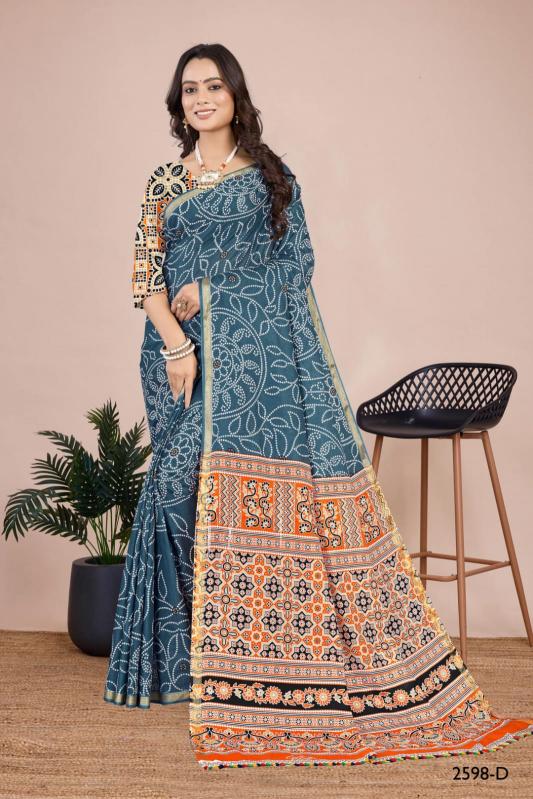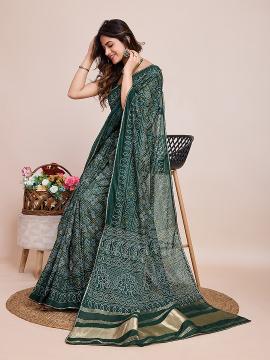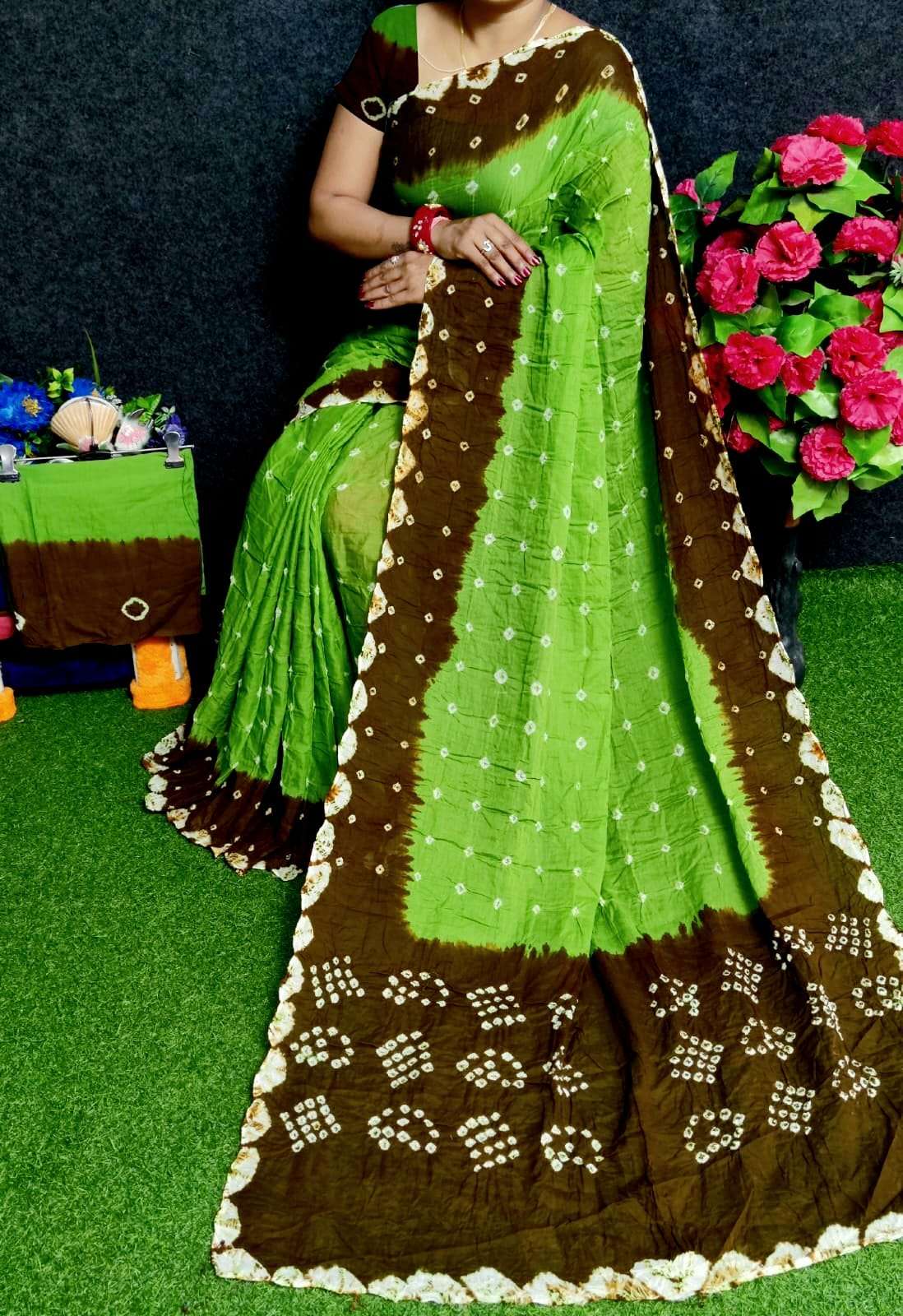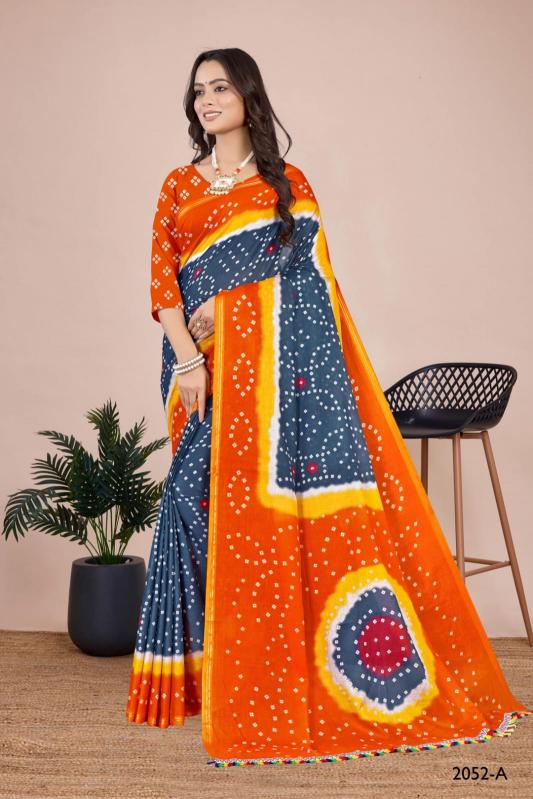
Dazira Rangt Vol 2 D- 2052 ABCD Bandhej Saree Wholesale Catalog
4 pcs Bundle
Your Profit:(58.38%)
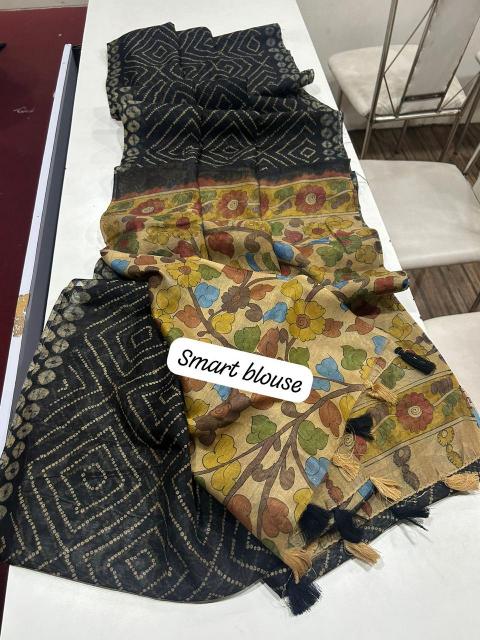
Dazira Linen Digital Print Vol 14 india bandhani saree
8 pcs Bundle
Your Profit:(55.29%)

Sabella Rich and premium Rich and premium moonga soft silk bandhani saree online shopping india
3 pcs Bundle

Your Profit:(62.14%)

Archana Bandhani Special – Cotton sarees - Wholesale Catalog
20 pcs Bundle
Your Profit:(50%)

Sabella Linen Digital Print Vol 5 bandhani saree price in india
9 pcs Bundle
Your Profit:(46.28%)

Sabella Pure Soft Russian Bandhej Silk Pattu Saree price in india
6 pcs Bundle
Your Profit:(51.55%)

Chaya Art Silk With Zari Weaving Bandhej Saree Wholesale catalog
6 pcs Bundle
Your Profit:(69.89%)
Bandhani Sarees Surat at Wholesale Catalog
A Bandhani saree is a traditional Indian garment that consists of a long piece of fabric (usually around 5 to 9 meters in length) that is draped elegantly around the body. It is typically worn with a blouse and a petticoat. The Bandhani technique involves tying small portions of the fabric with threads before dyeing, creating intricate and colorful patterns. After dyeing, the tied portions are released, revealing the undyed areas and forming a distinctive design. Wholesale Bandhani sarees are popular in Gujarat and Rajasthan, and they are often worn on special occasions, festivals, and weddings.
The History and Meaning Behind Bandhani Sarees
Bandhani sarees are a type of traditional Indian attire that is known for its unique tie-and-dye technique. "Bandhani" comes from the Sanskrit word "bandhana," which means "to tie." These sarees are created using a labor-intensive process in which small sections of the fabric are tied with threads before dyeing. This results in intricate and vibrant patterns on the fabric.
The process of making Bandhani sarees involves the following steps:
-
Tying: The fabric, usually lightweight cotton or silk, is first folded and tied at various points using threads. The tying creates resist points that prevent the dye from penetrating the tied sections.
-
Dyeing: After tying, the fabric is dipped into different colored dyes. The tied sections remain untouched by the dye, while the untied areas absorb the colors.
-
Re-tying and Re-dyeing: For intricate patterns and multi-colored designs, the fabric might undergo multiple rounds of tying and dyeing to achieve the desired effect.
-
Untying and Finishing: Once the desired colors and patterns are achieved, the tied threads are removed, revealing the intricate designs. The saree is then washed and finished.
The patterns on wholesale Bandhani sarees can range from small dots to more elaborate designs like waves, flowers, and geometric shapes. These sarees are often characterized by their bright and vibrant colors, making them popular choices for festive occasions, weddings, and traditional celebrations in various parts of India, especially in regions like Rajasthan and Gujarat.
Bandhani sarees are not only popular for their aesthetic appeal but also for the intricate craftsmanship involved in their creation. They showcase the rich cultural heritage of India and are cherished as unique pieces of traditional clothing.
How many colors are there in Bandhani Sarees?
Bandhani sarees can come in a wide range of colors. There is no specific limit to the number of colors that can be used in Bandhani patterns. The colors used in Gujarati Bandhani sarees are often vibrant and diverse, reflecting the preferences of the artisans and the regional traditions they come from.
Traditional Bandhani sarees Surat might feature a single color or a combination of two or more colors. The tie-and-dye technique allows for intricate patterns and gradients to be created using different colors. The choice of colors can also depend on the occasion the saree is intended for, the local cultural influences, and the current fashion trends.
Some common colors used in Bandhani sarees include bright red, vibrant blue, rich green, sunny yellow, deep purple, and more. The combination of colors can create visually stunning and appealing designs that make Bandhani sarees stand out as unique and exquisite pieces of clothing.
Bandhej Saree Price कहा से स्टार्ट होते है?
The price of Wholesale Bandhani Sarees (also known as Bandhej) sarees can vary widely depending on several factors, including the quality of the fabric, the intricacy of the tie-and-dye work, the region of production, the brand or designer, and the overall craftsmanship. As of my last knowledge update in Augest 2023, Bandhani sarees can start from a few ₹ 99 and go up to several ₹ 4999 or even more, especially for high-quality and designer pieces.
Inexpensive Bandhani sarees made from simpler fabrics with basic designs might be more budget-friendly, making them accessible to a wider range of customers. On the other hand, intricately crafted Bandhani sarees using premium fabrics like silk and featuring complex tie-and-dye patterns can command higher prices.
It's important to note that prices can change over time due to various factors, including inflation, market trends, and changes in the cost of materials and labor. If you're looking to purchase a Bandhani saree, it's recommended to check with reputable sellers or stores to get an accurate idea of the current pricing based on your preferences and requirements.For that Wholesale Catalog is famous in the world
What is Bandhani silk sarees?
Bandhani silk sarees are a luxurious variant of the traditional Bandhani sarees, which are known for their tie-and-dye patterns. In the case of Bandhani silk sarees, the tie-and-dye technique is applied to silk fabric, creating a combination of the intricate patterns of Bandhani and the smooth, elegant texture of silk.The combination of the lustrous silk fabric with the vibrant and intricate Bandhani patterns creates a stunning and elegant saree that is often worn for special occasions like weddings, festivals, and celebrations. Bandhani silk sarees can come in a range of colors, designs, and quality levels, which can impact their price. They are sought after for their exquisite craftsmanship, cultural significance, and the visual appeal that comes from the fusion of silk and traditional tie-and-dye artistry.
When purchasing Bandhani (also known as Bandhej) sarees or Bandhani Dress Materials, there are several factors to consider to ensure you're getting a quality product that suits your preferences. Here are some things to keep in mind:
Quality of Fabric: Whether you're buying a Bandhani saree or dress material, the quality of the fabric is crucial. Bandhani patterns can be applied to various fabrics, including cotton, silk, georgette, chiffon, and more. Choose a fabric that aligns with your comfort and the occasion you plan to wear it for.
the primary difference between Bandhani sarees and wholesale sarees lies in the production technique (tie-and-dye for Bandhani) and the type of fabric used (cotton for cotton sarees). Both types of sarees have their unique qualities and are chosen based on occasions, comfort, and personal preferences.
You always keep seeing new garments and clothes.That's why we have made a lot of saree category,
you can see by clicking on it.
Wholesale Cotton Sarees | Silk Sarees wholesale | Designer sarees Wholesale | Cotton Kurtis Wholesale | Designer Kurtis


